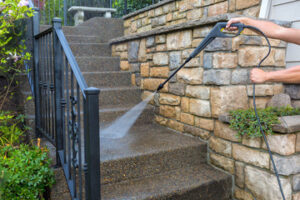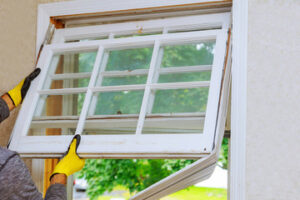The key to a well-operating window is making sure it’s square and straight. Check by measuring diagonally in the corners and adjusting with wood shims, as needed.

Vacuum debris from the frame opening, then apply two continuous beads of caulk along the sill and on the header and vertical sides. Call Window Replacement Austin for trusted advice.
Many factors impact the cost of window replacement. For example, larger windows cost more to replace than smaller windows because of the materials and weight involved. Window styles can also add to the price. If you choose to get a double-pane window, for example, you’ll pay more than a single-pane window because of the extra energy efficiency and insulation it offers. Additional features such as low-emissivity coating or argon gas filling can increase the price of your windows even more.
Window frame materials also impact the cost of replacement windows. Solid wood frames tend to be the most expensive but offer a classic, customizable look and are durable. Aluminum frames are less expensive and easy to maintain but don’t offer as much insulation as other types of frames. Vinyl frames are affordable, long-lasting, and more energy efficient than aluminum. They’re also available in a variety of colors and finishes to match your home’s exterior.
Another major factor in window replacement costs is location. For instance, if your windows are in hard-to-reach areas or require custom sizes or a lot of structural modification, the installation will be more expensive. Additionally, if your home needs repairs to siding or drywall as a result of the removal and installation of new windows, those costs will be added to the total window replacement price.
When you’re shopping for new windows, it’s important to keep in mind your overall budget. Window replacement can add up quickly, especially if you want to upgrade your entire home. To help you stay on budget, make a list of all the windows in your home that need to be replaced and determine the approximate cost of each.
Then, compare prices from several different window companies to find the best deal. Window companies are aware that homeowners have a variety of needs and budgets, so they often leave room for negotiation. If you’re replacing multiple windows in your home, you may be able to negotiate a discount if you buy them all at once or take advantage of specials being offered in your area by window contractors.
Window Replacement Options
If you’re thinking about replacing your windows, it’s important to understand the different options available. Window replacement and installation methods can impact cost, energy efficiency and aesthetics. Choosing the right window type and installation method can help you save money, increase the value of your home and enjoy long-lasting performance.
The most common types of windows used for replacement are single- and double-hung, casement, awning, bay & bow, sliding and fixed. These windows come in a wide range of shapes and sizes and can be made from wood, fiberglass or vinyl clad or clad with wood, aluminum, or bronze. Newer vinyl and fiberglass frames offer greater durability, are easier to maintain and are more energy efficient than older wood or aluminum-clad frames.
Most windows have their own warranty, and installing the window properly is key to maximizing the warranty terms. A typical window replacement warranty lasts 10 years, though some brands and models offer warranties up to 20 years or even promise a lifetime warranty, says Andrii Gurskyi, owner of New York City-based Mr. Glazier Windows and Doors. Installation warranties typically run from one to five years and should cover labor, parts and other aspects of the installation process.
It’s also worth noting that newer windows are more energy efficient than older ones, but proper installation is critical to achieving this efficiency. For example, newer windows can have insulation between the frame and glass, but this will only work if the frame is installed correctly. Installing the window with nail fins attached to the studs rather than just slotting the frame into place will create an airtight seal that cuts down on energy loss and reduces heating and cooling costs.
Some homeowners choose to replace just the sashes (the upper and lower window panes) of their existing windows, which is called a pocket replacement. Other homeowners will need a full frame replacement, which involves removing the entire old window and sill and installing a new window with an attached frame. This is often necessary when the existing window frame is damaged or rotting, or when local building codes require a complete tear-out and replacement.
Window Replacement Companies
When hiring home window replacement companies, look for ones that provide a variety of options for materials and styles and a comprehensive installation service. Ask for references from past clients, and check online reviews on Google, Angi, BBB and Yelp.
Make sure the company you choose is licensed to do business in your state, and that all installers have proper certification. Installers with Fenestration and Glazing Industry Alliance (formerly AAMA) or National Glass Association certification have demonstrated that they have received training in installation best practices. Those without proper credentials may not have the experience or expertise to do the job properly, leading to future problems like drafts and water leaks.
Expert installation is essential for the performance and longevity of your new windows. Poor installation can result in higher energy bills and more frequent maintenance issues, so be sure to hire experienced local installers. Some of the top home window replacement companies in New York also offer extensive warranty coverage and flexible financing options to make their services more affordable.
If you can’t find any references from local homeowners, ask the company for a list of projects they’ve completed recently in your area. You can then visit these homes to get a feel for the quality of the work and the company’s communication standards.
Some companies, such as Universal Windows & Doors, manufacture their own windows and doors, while others sell, install and warrant multiple brands of windows. The latter option can help you avoid getting hung up on price and focus more on finding the right products for your needs and budget.
Some window companies offer “lifetime” warranties on their products, while others only cover specific parts of the window for a set period of time. Read the fine print carefully to determine what’s covered, and how long the warranty lasts. The warranty should be in writing and include all applicable terms and conditions, including any exclusions or limitations. You can also consider working with a company that offers an extended limited lifetime warranty, which covers the windows for as long as you own your home.
Window Replacement Financing
Window replacement is a major investment that improves your home’s value, comfort, and beauty. However, these benefits come at a price, and it can be challenging to find financing options that work for your situation. Fortunately, there are several solid window financing options that can help you get the windows you want without breaking your budget.
Before applying for window replacement financing, gather as much information as you can about the types of windows you need and their cost in your area. Then, figure out how much you have available in your savings or checking accounts. You should also review your financial records and locate firm numbers for your current assets and debts, including home mortgage documents.
Once you have gathered your information, begin the application process for your preferred window financing option. The window company you choose may offer their own financing, or they might partner with a third-party lender to provide the best possible window financing for their clients. Some of the most popular window financing options include personal loans, home equity loans, and FHA rehab loans. A personal loan is a good option for homeowners with good credit who need a lump sum to pay for their new windows. Home equity loans require homeowners to borrow against the value of their homes, and these types of loans typically have lower interest rates than personal loans. An FHA rehab loan allows homeowners to roll the cost of their renovations, such as window replacement, into their mortgage and pay it off over time.
When applying for window financing, you should look at the terms and conditions carefully to ensure you are getting the best possible deal. Look for a flexible repayment schedule, no prepayment penalties, and low APRs, which should be below the national average. You should also compare offers from different lenders to find the best window financing for your needs and budget.
One of the most important aspects of window financing is that it enables you to complete your project sooner than you might otherwise be able to. This means that you can enjoy the comfort and security of your new windows sooner, and it can help reduce energy costs as soon as the windows are installed.








